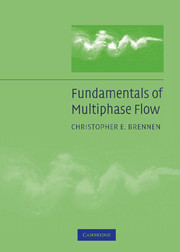Book contents
- Frontmatter
- Contents
- Preface
- Nomenclature
- 1 Introduction to Multiphase Flow
- 2 Single-Particle Motion
- 3 Bubble or Droplet Translation
- 4 Bubble Growth and Collapse
- 5 Cavitation
- 6 Boiling and Condensation
- 7 Flow Patterns
- 8 Internal Flow Energy Conversion
- 9 Homogeneous Flows
- 10 Flows with Bubble Dynamics
- 11 Flows with Gas Dynamics
- 12 Sprays
- 13 Granular Flows
- 14 Drift Flux Models
- 15 System Instabilities
- 16 Kinematic Waves
- Bibliography
- Index
2 - Single-Particle Motion
Published online by Cambridge University Press: 05 June 2014
- Frontmatter
- Contents
- Preface
- Nomenclature
- 1 Introduction to Multiphase Flow
- 2 Single-Particle Motion
- 3 Bubble or Droplet Translation
- 4 Bubble Growth and Collapse
- 5 Cavitation
- 6 Boiling and Condensation
- 7 Flow Patterns
- 8 Internal Flow Energy Conversion
- 9 Homogeneous Flows
- 10 Flows with Bubble Dynamics
- 11 Flows with Gas Dynamics
- 12 Sprays
- 13 Granular Flows
- 14 Drift Flux Models
- 15 System Instabilities
- 16 Kinematic Waves
- Bibliography
- Index
Summary
Introduction
This chapter briefly reviews the issues and problems involved in constructing the equations of motion for individual particles, drops, or bubbles moving through a fluid. For convenience we use the generic name particle to refer to the finite pieces of the disperse phase or component. The analyses are implicitly confined to those circumstances in which the interactions between neighboring particles are negligible. In very dilute multiphase flows in which the particles are very small compared with the global dimensions of the flow and are very far apart compared with the particle size, it is often sufficient to solve for the velocity and pressure, ui (xi, t) and p(xi, t), of the continuous suspending fluid while ignoring the particles or disperse phase. Given this solution one could then solve an equation of motion for the particle to determine its trajectory. This chapter focuses on the construction of such a particle or bubble equation of motion.
The body of fluid mechanical literature on the subject of flows around particles or bodies is very large indeed. Here we present a summary that focuses on a spherical particle of radius R and employs the following common notation. The components of the translational velocity of the center of the particle is denoted by Vi(t). The velocity that the fluid would have had at the location of the particle center in the absence of the particle is denoted by Ui(t).
- Type
- Chapter
- Information
- Fundamentals of Multiphase Flow , pp. 30 - 59Publisher: Cambridge University PressPrint publication year: 2005

